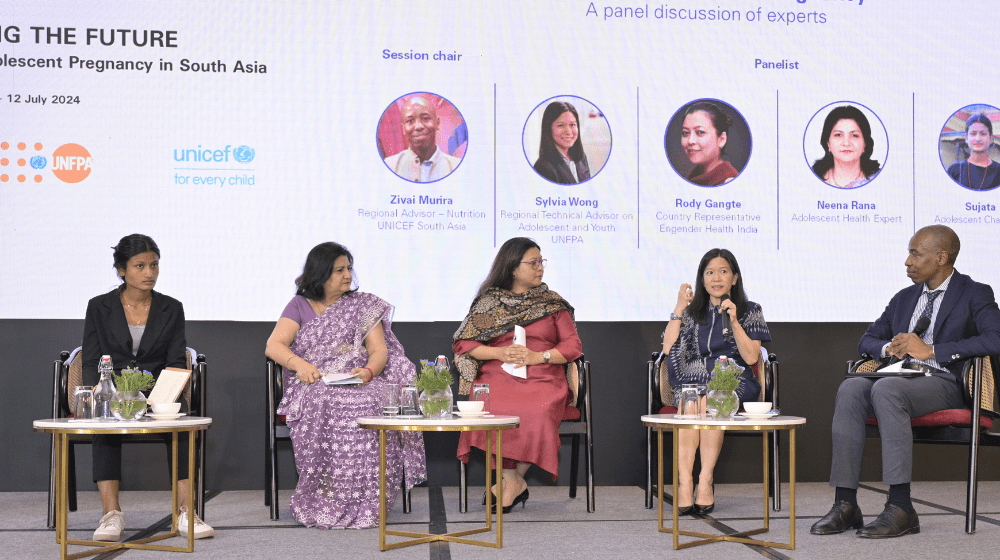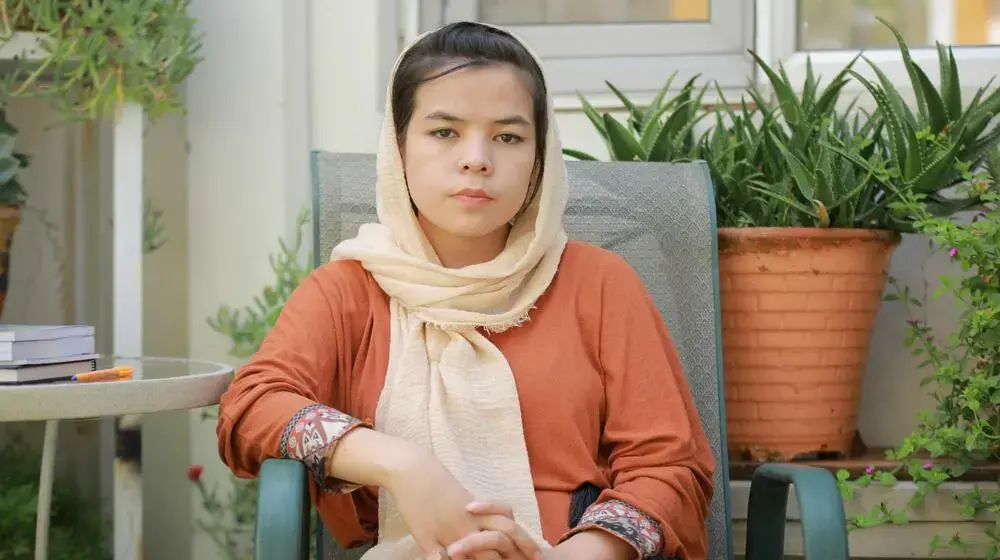KATHMANDU, 12 July 2024: SAARC, UNICEF South Asia, UNFPA Asia Pacific and WHO called for increased commitment for critical services for over 2.2 million adolescent girls that give birth yearly in South Asia.
This call came at the Regional Dialogue on Adolescent Pregnancy in South Asia, which is being held in Kathmandu over 11-12 July 2024. Jointly organized by the agencies, the event was inaugurated by the Secretary General of SAARC, Ambassador Golam Sarwar.
“I appreciate the role of governments, UN agencies, NGOs and civil society for the improvements made by the SAARC region over the years in reducing teenage pregnancy,” said Ambassador Golam Sarwar, the Secretary General of SAARC. “But the region still has a long way to go. I call upon everyone to resolutely address the root causes including child marriage, access to adolescent health education, and removing social stigma in managing teenage population of SAARC region.”
Every year, nearly 6,500 adolescent girls die in childbirth in South Asia, as per an analysis by UNCEF, WHO and UNFPA. Most of them are child brides who have limited power over their reproductive health or lives. In fact, South Asia accounts for 290 million child brides - nearly half of the world’s burden. In three countries of South Asia, they are also four times more likely to be out of school than their unmarried peers. One of them is Geetu Kumari who addressed the participants at the regional dialogue.
”I never got the strength back after my caesarean section operation,” said Geetu Kumari from Nepal who got married at 16 and was pregnant soon after. “I still feel weak and find it difficult to do housework and take care of my baby. I just want to be healthy again. I also want to work and earn money. I’ve studied till 10th grade, so I am ready to continue my studies or find work.”
When young girls give birth, their lives can be at risk as they are not yet physically ready to give birth. Thousands more girls are forced to drop out of school, face stigma, rejection, violence, unemployment as well as lifelong social challenges. Forty-nine per cent of young girls in South Asia are not in education, employment or training – the highest in the world.
“We must do better for adolescent girls, particularly those who are married, pregnant or parents. In addition to hurdles to learn, get good healthcare and eat nutritious food, they are denied the opportunity to build skills and start businesses -- everything they need as parents to thrive and fulfil their potential,” said Sanjay Wijesekera, UNICEF Regional Director for South Asia. “We must work together and invest in opportunities to unleash the promise of more than 170 million adolescent girls in South Asia. Doing so would be transformative for this region.”
Government and UN officials, adolescent girls, as well as civil society representatives from Afghanistan, Bangladesh, Bhutan, India, Maldives, Nepal, Pakistan and Sri Lanka have participated in the dialogue and reaffirmed their commitment in providing better services to support pregnant adolescent girls and young mothers. This includes opportunities to learn, set up their own businesses, and earn a living.
Adolescent mothers have a much higher risk of dying from maternal causes, compared to women in their 20s and 30s. These risks increase greatly as maternal age decreases, with adolescents under 16 years facing four times the risk of maternal death compared to women over 20 years. Adolescent mothers are also vulnerable to maternal morbidities, including obstetric fistula. Babies born to adolescents also face a significantly higher risk of death compared to babies born to older women.
Evidence shows that pregnant adolescents face poorer health coverage than adults. These include antenatal care, postnatal care, delivering with a skilled birth attendant, and family planning. Even if they do have care, these adolescents often lack the confidence to express their needs. They face greater stigma, humiliation and disrespect and receive poorer quality care than adults.
“It is high time that we reverse this trend. The unique physical, cognitive, social, emotional, and sexual development during adolescence necessitates special attention in national and international policies. Effective strategies to tackle adolescent pregnancy require cross-sectoral collaboration and equitable access to a variety of services,” said Ms Saima Wazed, Regional Director, WHO South-East Asia. “Investments in adolescent health are essential for promoting healthy socio-economic development and preventing health risks and problems before their onset. This supports the wellbeing of the youth of today - who are the human capital of tomorrow.”
Programmes to combat child marriage and improve care for pregnant adolescents and young mothers have gained momentum across South Asia. But more needs to be done, including programmes to challenge entrenched social and gender norms, build their confidence, equip them with life skills, help them get the right education, work opportunities, and access to sexual and reproductive health including family planning.
“In many of our countries, major demographic shifts are taking place and have created a temporary ‘youth bulge’, for which, when we invest in adolescents and youth’s education, health, life skills, and employment opportunities, countries can build their young people’s capabilities and human capital,” said Dr Aleksandar Sasha Bodiroza, the Deputy Regional Director of UNFPA in the Asia and Pacific. “When their rights are upheld, healthy, educated, and skilled young women become a driving force for their countries’ sustainable development and build a better future for all. Quite simply, empowering girls is both the smart and right thing to do.”
To deliver on the rights of every adolescent girl who is pregnant, married or a parent, SAARC members, UNICEF, UNFPA, WHO, non-governmental and civil society organizations are calling for better data collection and analysis to design policies and programmes; improved care; opportunities for educational and vocational skills training; and information on family planning.
”My request to organizations is that you should continue to raise awareness about child marriage and teenage pregnancy. It is not good for our health and our lives stop as soon as we become mothers,” adds Geetu Kumari. “Please work with both men and women to create opportunities for girls.”
######
The analysis is based on data from UNFPA and UNICEF. Adolescent girls are girls between 10 – 19 years of age.
Sabrina Sidhu, UNICEF South Asia, +91 9384030106, ssidhu@unicef.org
Kenosha Kumaresan, UNFPA, +66 62 603 8015, kumaresan@unfpa.org
Shamila Sharma, WHO South-East Asia, +91 9818287256, sharmasha@who.int
The South Asian Association for Regional Cooperation (SAARC) was established with the signing of the SAARC Charter in Dhaka on 8 December 1985. SAARC comprises of eight Member States: Afghanistan, Bangladesh, Bhutan, India, Maldives, Nepal, Pakistan and Sri Lanka. The Secretariat of the Association was set up in Kathmandu on 17 January 1987. The objectives of the Association as outlined in the SAARC Charter are: to promote the welfare of the peoples of South Asia and to improve their quality of life; to accelerate economic growth, social progress and cultural development in the region and to provide all individuals the opportunity to live in dignity and to realize their full potentials; to promote and strengthen collective self-reliance among the countries of South Asia; to contribute to mutual trust, understanding and appreciation of one another's problems; to promote active collaboration and mutual assistance in the economic, social, cultural, technical and scientific fields; to strengthen cooperation with other developing countries; to strengthen cooperation among themselves in international forums on matters of common interests; and to cooperate with international and regional organizations with similar aims and purposes.
About UNICEF
UNICEF works in some of the world’s toughest places, to reach the world’s most disadvantaged children. Across 190 countries and territories, we work for every child, everywhere, to build a better world for everyone. UNICEF’s Regional Office for South Asia (ROSA) works with UNICEF Country Offices in Afghanistan, Bangladesh, Bhutan, India, the Maldives, Nepal, Pakistan and Sri Lanka to help to save children’s lives, defend their rights, and help them fulfil their potential. For more information about UNICEF’s work for children in South Asia, visit www.unicef.org/rosa and follow UNICEF ROSA on Twitter and Facebook.
About UNFPA
UNFPA is the United Nations sexual and reproductive health agency. Our mission is to deliver a world where every pregnancy is wanted, every childbirth is safe and every young person's potential is fulfilled. We promote gender equality and empower women, girls and young people to take control of their bodies and their futures. We work with partners in more than 150 countries to provide access to a wide range of sexual and reproductive health services. Our goal is ending unmet need for family planning, preventable maternal death, and gender-based violence and harmful practices including child marriage and female genital mutilation by 2030. asiapacific.unfpa.org | Twitter (X) | Facebook | Instagram
About WHO
Dedicated to the well-being of all people and guided by science, the World Health Organization leads and champions global efforts to give everyone, everywhere an equal chance to live a healthy life. Working with 194 Member States across 6 regions and on the ground in 150+ locations, the WHO team works to improve everyone’s ability to enjoy good health and well-being.
About WHO
About UNFPA
About Other Partners
- About WHO
- About UNFPA
- About Other Partners





